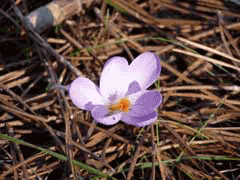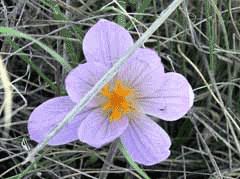 |
|
http://commons.wikimedia.org/wiki/User:Tintazul |
 |
| http://picasaweb.google.com/lh/photo/c1QNhyXPIxMTuxdciOsz-g |
Translate this page:
Summary
Physical Characteristics

 Crocus serotinus is a CORM growing to 0.1 m (0ft 4in).
Crocus serotinus is a CORM growing to 0.1 m (0ft 4in).
See above for USDA hardiness. It is hardy to UK zone 6 and is not frost tender. It is in leaf from November to May, in flower from November to December. The species is hermaphrodite (has both male and female organs) and is pollinated by Bees, butterflies.
Suitable for: light (sandy) and medium (loamy) soils. Suitable pH: mildly acid, neutral and basic (mildly alkaline) soils. It can grow in semi-shade (light woodland) or no shade. It prefers dry or moist soil.
UK Hardiness Map
US Hardiness Map
Synonyms
Plant Habitats
Woodland Garden Dappled Shade; Cultivated Beds;
Edible Uses
Edible Parts:
Edible Uses: Colouring Condiment
The flowers are used as a saffron substitute in flavouring food and colouring it yellow[177, 183].
References More on Edible Uses
Medicinal Uses
Plants For A Future can not take any responsibility for any adverse effects from the use of plants. Always seek advice from a professional before using a plant medicinally.
None known
References More on Medicinal Uses
The Bookshop: Edible Plant Books
Our Latest books on Perennial Plants For Food Forests and Permaculture Gardens in paperback or digital formats.

Edible Tropical Plants
Food Forest Plants for Hotter Conditions: 250+ Plants For Tropical Food Forests & Permaculture Gardens.
More

Edible Temperate Plants
Plants for Your Food Forest: 500 Plants for Temperate Food Forests & Permaculture Gardens.
More

More Books
PFAF have eight books available in paperback and digital formats. Browse the shop for more information.
Shop Now
Other Uses
Dye
The yellow dye obtained from the stigmas yields a yellow dye, it is a saffron substitute[177].
Special Uses
References More on Other Uses
Cultivation details
Succeeds in most soils, conditions and positions[1]. Plants grow well in a peaty soil in a bulb frame and should succeed outdoors in a sandy peaty soil[90]. The subspecies C. serotinus austriacus can be naturalized in grass or beneath deep rooting trees on light well-drained soils[200]. Plants tend to move considerably from their original planting place because of their means of vegetative reproduction, it is therefore wise not to grow different species in close proximity[1]. Any planting out is best done in late spring or early summer[245]. Mice are very fond of the corms of this species[1]. Plants take 3 - 4 years to flower from seed[200]. The flowers are only open during the day time, closing at night[245].
References Carbon Farming Information and Carbon Sequestration Information
Temperature Converter
Type a value in the Celsius field to convert the value to Fahrenheit:
Fahrenheit:
The PFAF Bookshop
Plants For A Future have a number of books available in paperback and digital form. Book titles include Edible Plants, Edible Perennials, Edible Trees,Edible Shrubs, Woodland Gardening, and Temperate Food Forest Plants. Our new book is Food Forest Plants For Hotter Conditions (Tropical and Sub-Tropical).
Shop Now
Plant Propagation
Seed - best sown as soon as it is ripe in a light sandy soil in pots in a cold frame[1]. The seed can also be sown in a cold frame in early spring[1]. Sow thinly because the seed usually germinates freely[1], within 1 - 6 months at 18°c[164]. Unless the seed has been sown too thickly, do not transplant the seedlings in their first year of growth, but give them regular liquid feeds to make sure they do not become deficient. Divide the small bulbs once the plants have died down, planting 2 - 3 bulbs per 8cm pot. Grow them on for another 2 years in a greenhouse or frame and plant them out into their permanent positions when dormant in late summer[K]. Plants take 3 - 4 years to flower from seed[200]. Division f the clumps after the leaves die down in spring[1, 200]. The bulbs can be planted out direct into their permanent positions.
Other Names
If available other names are mentioned here
Native Range
EUROPE: Spain, Portugal AFRICA: Morocco
Weed Potential
Right plant wrong place. We are currently updating this section.
Please note that a plant may be invasive in one area but may not in your area so it's worth checking.
Conservation Status
IUCN Red List of Threatened Plants Status :

Growth: S = slow M = medium F = fast. Soil: L = light (sandy) M = medium H = heavy (clay). pH: A = acid N = neutral B = basic (alkaline). Shade: F = full shade S = semi-shade N = no shade. Moisture: D = dry M = Moist We = wet Wa = water.
Now available:
Food Forest Plants for Mediterranean Conditions
350+ Perennial Plants For Mediterranean and Drier Food Forests and Permaculture Gardens.
[Paperback and eBook]
This is the third in Plants For A Future's series of plant guides for food forests tailored to
specific climate zones. Following volumes on temperate and tropical ecosystems, this book focuses
on species suited to Mediterranean conditions—regions with hot, dry summers and cool, wet winters,
often facing the added challenge of climate change.
Read More
Expert comment
Author
Salisb.
Botanical References
200
Links / References
For a list of references used on this page please go here
Readers comment
| Add a comment |
|
If you have important information about this plant that may help other users please add a comment or link below. Only comments or links that are felt to be directly relevant to a plant will be included. If you think a comment/link or information contained on this page is inaccurate or misleading we would welcome your feedback at [email protected]. If you have questions about a plant please use the Forum on this website as we do not have the resources to answer questions ourselves.
* Please note: the comments by website users are not necessarily those held by PFAF and may give misleading or inaccurate information.
To leave a comment please Register or login here All comments need to be approved so will not appear immediately.
|
Subject : Crocus serotinus
|
|
|
|